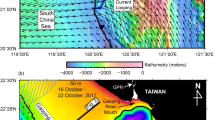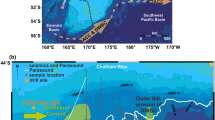Abstract
The method of seismic oceanography was applied to identify fine structure and pathways of the Western Boundary Undercurrent (WBUC) at Eirik Drift, 200 km south of Greenland. Three high-velocity cores of the WBUC were distinguished: a deep core in depths >2600 m which carries Denmark Strait Overflow Water, an upper core in depths between ~1900 and 3000 m transporting Iceland–Scotland Overflow Water, and a split-off of this upper core, which crosses the main crest of Eirik Drift at depths between ~1900 and 2400 m. For the upper WBUC core a detailed analysis of the structure was conducted. The WBUC core has as a domed structure, which changes in style, width and height above seafloor along the lines of the changing topography. We proved not only the influence of the topography on pathway and structure of the WBUC core but also that this information cannot be gained by measuring the overflow waters with discrete CTD stations.








Similar content being viewed by others
References
Buffett GG et al (2009) Seismic reflection along the path of the mediterranean undercurrent. Cont Shelf Res 29:1848–1860. doi:10.1016/j.csr.2009.05.017
Chen C-T, Millero FJ (1977) Speed of sound in seawater at high pressures. J Acoust Soc Am 62:1129–1135
Dickson RR, Brown J (1994) The production of North Atlantic Deep Water: sources, rates, and pathways. J Geophys Res 99:12319–12341. doi:10.1029/94jc00530
Fortin WFJ, Holbrook WS (2009) Sound speed requirements for optimal imaging of seismic oceanographic data. Geophys Res Lett. doi:10.1029/2009GL038991
Hillaire-Marcel C, de Vernal A, McKay J (2011) Foraminifer isotope study of the Pleistocene Labrador Sea, northwest North Atlantic (IODP Sites 1302/03 and 1305), with emphasis on paleoceanographical differences between its “inner” and “outer” basins. Mar Geol 279:188–198. doi:10.1016/j.margeo.2010.11.001
Holbrook WS, Paramo P, Pearse S, Schmitt RW (2003) Thermohaline fine structure in an oceanographic front from seismic reflection profiling. Science 301:821–824
Holliday NP, Bacon S, Allen J, McDonagh EL (2009) Circulation and transport in the western boundary currents at Cape Farewell, Greenland. J Phys Oceanogr 39:1854–1870. doi:10.1175/2009JPO4160.1
Hunter S, Wilkinson D, Louarn E, McCave IN, Rohling E, Stow DA, Bacon S (2007) Deep western boundary current dynamics and associated sedimentation on the Eirik Drift, Southern Greenland Margin. Deep Sea Res I 54:2036–2066. doi:10.1016/j.dsr.2007.09.007
Müller-Michaelis A, Uenzelmann-Neben G (2014) Development of the Western Boundary Undercurrent at Eirik Drift related to changing climate since the early Miocene. Deep Sea Res I 93:21–34. doi:10.1016/j.dsr.2014.07.010
Nandi P, Holbrook WS, Pearse S, Paramo P, Schmitt RW (2004) Seismic reflection imaging of water mass boundaries in the Norwegian Sea. Geophys Res Lett. doi:10.1029/2004GL021325
Quadfasel D, Käse R (2007) Present-day manifestation of the Nordic seas overflows. In: Schmittner A, Chiang JCH, Hemming SR (eds) Ocean circulation: mechanisms and impacts—past and future changes of meridional overturning. Geophysical monograph series, 173rd edn. American Geophysical Union, Washington, DC, pp 75–89
Rhein M (1994) The deep western boundary current: tracers and velocities. Deep Sea Res I 41:263–281
Rhein M (2011) Strength of the subpolar gyre and the formation of deep water MSM 12-3. Institut für Meereskunde, Hamburg
Ruddick B, Song H, Dong C, Pinheiro L (2009) Water column seismic images as maps of temperature gradient. Oceanography 22:193–205
Sandwell DT, Smith WHF (1997) Marine gravity anomaly from Geosat and ERS 1 satellite altimetry. J Geophys Res B102:10039–10054
Saunders PM (2001) The dense northern overflows. In: Siedler G, Church J (eds) Ocean circulation and climate: observing and modelling the global ocean. Academic Press, San Francisco, pp 401–418
Schmitz WJ Jr (1996) On the world ocean circulation, volume 1, some global features/North Atlantic circulation. Woods Hole Oceanographic Institution, Woods Hole, MA
Stanford JD, Rohling EJ, Bacon S, Holliday NP (2011) A review of the deep and surface currents around Eirik Drift, South of Greenland: comparison of the past with the present. Glob Planet Change 79:244–254. doi:10.1016/j.gloplacha.2011.02.001
Vsemirnova EA, Hobbs RW, Hosegood P (2012) Mapping turbidity layers using seismic oceanography methods. Ocean Sci 8.1:1–18. doi:10.5194/os-8-11-2012
Wold CN (1994) Cenozoic sediment accumulation on drifts in the Northern North Atlantic. Paleoceanography 9:917–941
Yilmaz Ö (2001) Seismic data analysis vol 10. Investigations in geophysics. Society of Exploration Geophysicists, Tulsa
Acknowledgments
We are grateful for the support of Captain F. von Staa, his officers and crew during RV Maria S. Merian cruise MSM12/2. We want to thank Cord Papenberg and Dirk Klaeschen for the introduction to seismic unix, the use of their pre-processing algorithms and the code to perform the adaptive subtraction of the estimated direct wave. Further, we want to thank Monika Rhein for supplying the MSM12/3 CTD data. The data collection was funded within the program METEOR/MERIAN provided by the Deutsche Forschungsgemeinschaft (DFG). This work was funded by the DFG under Contract No. Ue 49/12.
Author information
Authors and Affiliations
Corresponding author
Rights and permissions
About this article
Cite this article
Müller-Michaelis, A., Uenzelmann-Neben, G. Using seismic reflection data to reveal high-resolution structure and pathway of the upper Western Boundary Undercurrent core at Eirik Drift. Mar Geophys Res 36, 343–353 (2015). https://doi.org/10.1007/s11001-015-9255-y
Received:
Accepted:
Published:
Issue Date:
DOI: https://doi.org/10.1007/s11001-015-9255-y




